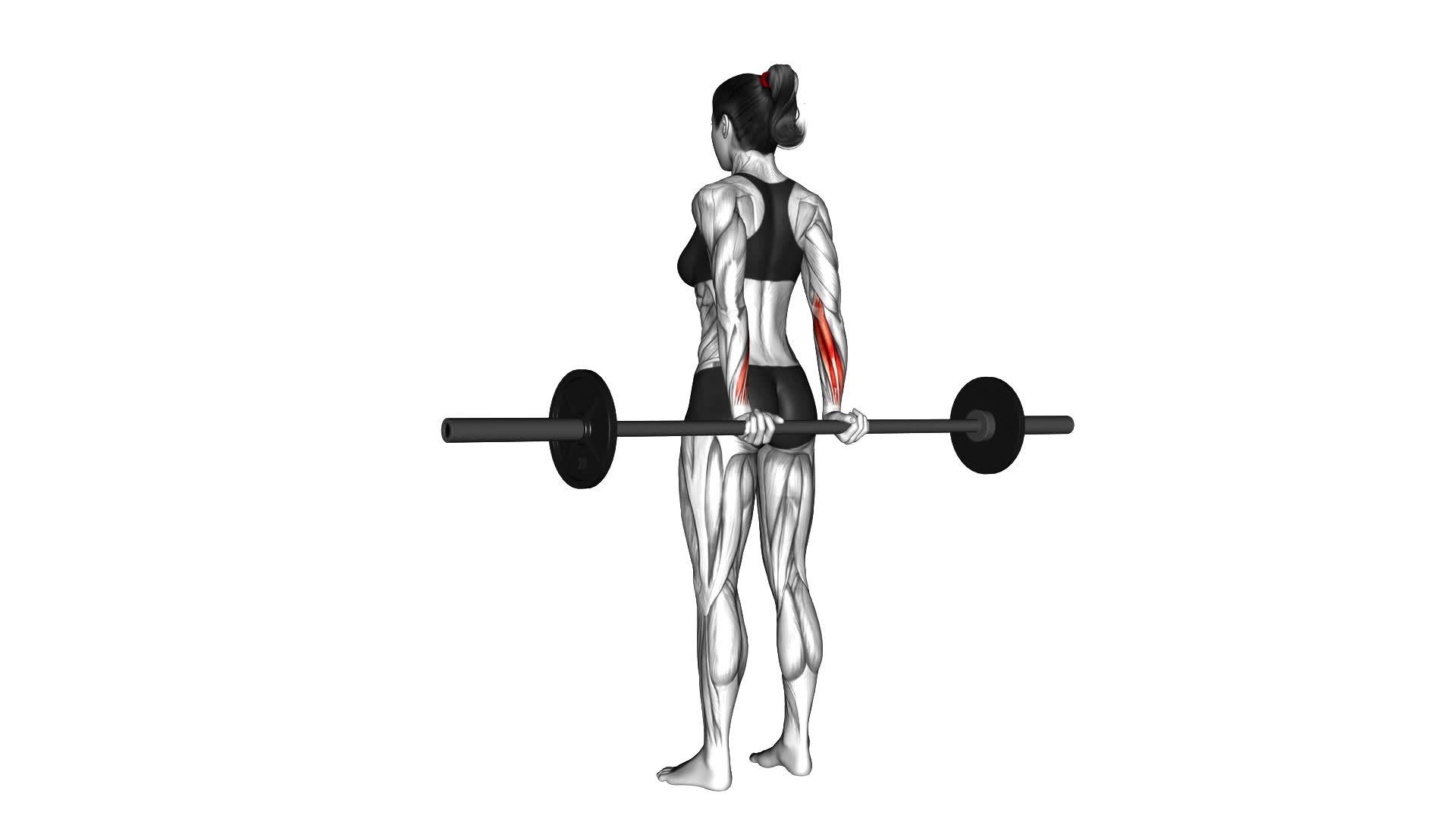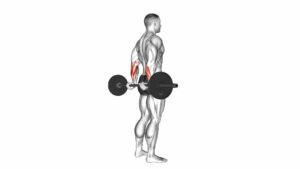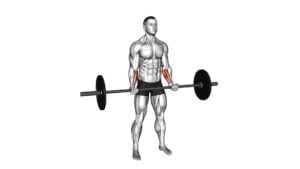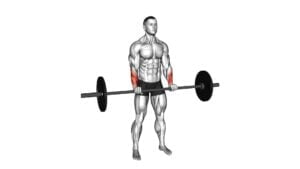Barbell Standing Back Wrist Curl (female) – Video Exercise Guide & Tips

Are you looking to strengthen your wrists and forearms? Look no further than the barbell standing back wrist curl. In this exercise, you'll target the muscles in your lower arms, improving your grip strength and overall wrist stability.
Watch This Exercise Video
Follow our video exercise guide and tips to ensure you have the correct equipment setup, body positioning, and execution. Avoid common mistakes and learn how to increase the intensity for maximum results.
Let's dive in and get those wrists strong!
Key Takeaways
- Proper equipment setup and body positioning are important for this exercise.
- Maintaining proper wrist alignment and grip is crucial for preventing injuries.
- Starting with lighter weights and gradually increasing the intensity helps improve strength and flexibility.
- Avoiding common mistakes such as using excessive weight or swinging the barbell enhances the effectiveness of the exercise.
Proper Equipment Setup
How do you properly set up the equipment for the Barbell Standing Back Wrist Curl exercise?
Proper equipment placement and wrist flexibility are essential for performing this exercise effectively.
To begin, position yourself in front of a barbell rack with the bar at waist height. Place your feet shoulder-width apart, ensuring a stable base.
Grasp the bar with an overhand grip, hands slightly wider than shoulder-width apart. Your palms should be facing down, and your wrists should be in line with your forearms. This starting position ensures that your wrists are properly aligned and supported throughout the exercise.
Next, check your wrist flexibility. If you have limited flexibility, it's important to warm up your wrists before starting the exercise. Perform some wrist circles and stretches to loosen up the joint and increase your range of motion.
Once you have set up the equipment and ensured proper wrist flexibility, you're ready to begin the Barbell Standing Back Wrist Curl exercise. Remember to maintain proper form and control throughout the movement to avoid injury and maximize the benefits.
Correct Body Positioning
To achieve proper form and optimize the effectiveness of the Barbell Standing Back Wrist Curl exercise, position your body correctly. Follow these guidelines for correct body positioning:
- Stand with your feet shoulder-width apart, ensuring a stable base of support.
- Keep your back straight and your core engaged to maintain proper body alignment throughout the exercise.
- Hold the barbell with an overhand grip, keeping your wrists in a neutral position.
Proper body alignment is crucial for this exercise as it helps to target the muscles effectively and prevent injuries. By aligning your body correctly, you can ensure that the targeted muscles are activated and engaged throughout the movement.
Maintaining proper body alignment also helps to minimize strain on other muscle groups and joints, allowing you to perform the exercise with greater efficiency and effectiveness.
Additionally, by activating the correct muscles, such as the forearm flexors and extensors, you can maximize the benefits of the Barbell Standing Back Wrist Curl exercise. Focus on contracting these muscles as you perform the movement to enhance their strength and endurance.
Step-by-Step Exercise Execution
To properly execute the Barbell Standing Back Wrist Curl exercise, you'll need to follow these step-by-step instructions.
First, stand with your feet shoulder-width apart and hold a barbell with an overhand grip, your hands slightly wider than shoulder-width apart. Your palms should be facing down towards the floor. This is the proper hand placement for this exercise.
Next, extend your arms fully and let the barbell rest against your thighs. Keep your upper arms stationary throughout the exercise. Begin by flexing your wrists, curling the barbell towards your body. Pause briefly at the top of the movement, then slowly lower the barbell back to the starting position.
When selecting a weight for this exercise, it's recommended to start with a lighter weight and gradually increase as you become more comfortable and confident with the movement. The recommended weight range will vary depending on your fitness level and strength.
By following these step-by-step instructions and using the proper hand placement, you can effectively target and strengthen your forearm muscles.
Now that you know how to properly execute the Barbell Standing Back Wrist Curl, let's move on to the next section where we'll discuss common mistakes to avoid.
Common Mistakes to Avoid
To ensure proper form and avoid injury, it's important to be aware of common mistakes when performing the Barbell Standing Back Wrist Curl exercise. Here are some common mistakes to avoid:
- Incorrect wrist alignment: One of the most common mistakes is allowing your wrists to bend or extend too much during the exercise. This puts unnecessary strain on your wrists and can lead to discomfort or injury. Make sure to maintain a neutral wrist position throughout the movement, keeping your wrists in line with your forearms.
- Using excessive weight: Another mistake to avoid is using too much weight. It may be tempting to lift heavy, but using excessive weight can compromise your form and increase the risk of injury. Start with a weight that allows you to perform the exercise with proper technique and gradually increase the weight as you get stronger.
- Neglecting proper technique: Lastly, neglecting proper technique is a common mistake. It's important to perform the exercise with control and precision, focusing on the targeted muscles. Avoid swinging or using momentum to lift the weight, as this takes away from the effectiveness of the exercise.
Tips for Increasing Intensity and Progression
To increase the intensity and progression of the Barbell Standing Back Wrist Curl exercise, you can incorporate the following tips.
- Consider increasing the weight you're using. Gradually adding more weight to the barbell will challenge your muscles and help you progress. Start with a weight that allows you to complete the exercise with proper form, and then gradually increase the weight as you get stronger.
- Another way to increase the intensity of this exercise is to incorporate resistance bands. Loop a resistance band around the barbell and hold onto the ends of the band with your hands. This will add an extra challenge to your wrist curls, as the resistance band increases tension throughout the movement. Start with a lighter resistance band and gradually progress to heavier bands as you become more comfortable.
- Remember to always listen to your body and not push yourself too hard. It's important to find the right balance between challenging yourself and avoiding injury.
- As you increase the weight or incorporate resistance bands, make sure to maintain proper form and technique to get the most out of this exercise.
Frequently Asked Questions
How Many Sets and Repetitions Should I Perform for the Barbell Standing Back Wrist Curl Exercise?
For the barbell standing back wrist curl exercise, it's important to warm up your wrists before starting.
As for sets and repetitions, it's recommended to start with 2-3 sets of 10-12 repetitions. However, you can adjust this based on your fitness level and goals.
If you have any injuries or limitations, it's best to modify the exercise or consult with a professional to avoid further damage.
Is It Necessary to Warm up Before Performing the Barbell Standing Back Wrist Curl Exercise?
Before performing any exercise, it's important to warm up properly. Warming up helps increase blood flow, loosen muscles, and prepare your body for the workout ahead. Additionally, warming up can help prevent injuries and improve your overall performance.
In the case of the barbell standing back wrist curl exercise, warming up is especially important as it involves the wrists and forearms. It's crucial to maintain proper form during this exercise to avoid strain or injury.
Can the Barbell Standing Back Wrist Curl Exercise Be Modified or Adjusted for Individuals With Wrist or Forearm Injuries?
Modified variations of the barbell standing back wrist curl exercise can be effective wrist exercises for individuals with wrist or forearm injuries. By adjusting the grip or using lighter weights, you can reduce strain on the injured area while still targeting the muscles.
It's important to consult with a healthcare professional or a qualified trainer to ensure proper form and to determine the best modifications for your specific injury.
Are There Any Alternative Exercises That Target the Same Muscle Groups as the Barbell Standing Back Wrist Curl?
If you're looking for alternative exercises that target the same muscle groups as the barbell standing back wrist curl, there are a few options you can try.
One option is the dumbbell wrist curl, which can be done sitting or standing.
Another alternative is the reverse wrist curl, which focuses on the muscles on the back of your forearm.
Additionally, you can also try using resistance bands for wrist curls.
These exercises can help you work the same muscle groups as the barbell standing back wrist curl.
How Long Should I Rest Between Sets When Performing the Barbell Standing Back Wrist Curl Exercise?
When performing the barbell standing back wrist curl exercise, it's important to consider rest periods and exercise intensity.
Rest periods between sets will vary depending on your fitness level and goals. Generally, it's recommended to rest for about 1-2 minutes between sets to allow your muscles to recover and maintain proper form.
However, if you're looking to increase the intensity of the exercise, you can decrease the rest periods to challenge your muscles even more.
Conclusion
To conclude, the barbell standing back wrist curl is an effective exercise for strengthening the wrist muscles. Proper equipment setup and correct body positioning are crucial for maximizing the benefits of this exercise.
By following the step-by-step execution and avoiding common mistakes, individuals can improve their wrist strength and flexibility.
Additionally, incorporating tips for increasing intensity and progression will help individuals achieve their fitness goals.

Author
Years ago, the spark of my life’s passion ignited in my mind the moment I stepped into the local gym for the first time. The inaugural bead of perspiration, the initial endeavor, the very first surge of endorphins, and a sense of pride that washed over me post-workout marked the beginning of my deep-seated interest in strength sports, fitness, and sports nutrition. This very curiosity blossomed rapidly into a profound fascination, propelling me to earn a Master’s degree in Physical Education from the Academy of Physical Education in Krakow, followed by a Sports Manager diploma from the Jagiellonian University. My journey of growth led me to gain more specialized qualifications, such as being a certified personal trainer with a focus on sports dietetics, a lifeguard, and an instructor for wellness and corrective gymnastics. Theoretical knowledge paired seamlessly with practical experience, reinforcing my belief that the transformation of individuals under my guidance was also a reflection of my personal growth. This belief holds true even today. Each day, I strive to push the boundaries and explore new realms. These realms gently elevate me to greater heights. The unique combination of passion for my field and the continuous quest for growth fuels my drive to break new ground.



